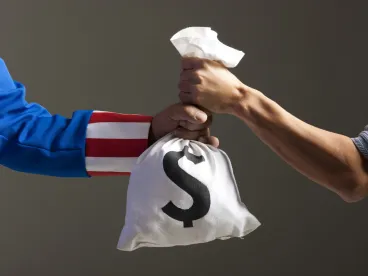On April 9, 2020 the Federal Reserve Bank and the Department of Treasury announced various new Fed-sponsored financing facilities financed with a Treasury infusion of $195 billion of the $454 billion provided to Treasury under the CARES Act for new Fed programs. These programs are designed to provide loan or bond financing to larger State and municipal entities and “businesses” with up to 10,000 employees or $2.5 billion in revenues or that meet certain rating requirements. Their applicability to non-profit organizations remains to be confirmed.
Municipal Liquidity Facility
This facility will support lending up to $500 billion in note purchases by a Fed-backed special purpose vehicle (SPV) from U.S. states and the District of Columbia (together, “States”), U.S. cities with a population exceeding one million residents (“Cities”), and U.S. counties with a population exceeding two million residents (“Counties”). Territories, such as Puerto Rico, appear to be excluded as “States.”
The SPV will purchase tax anticipation notes (TANs), tax and revenue anticipation notes (TRANs), bond anticipation notes (BANs), and other similar short-term notes maturing no later than 24 months from the date of issuance. Only one issuer in each State, City or County may directly sell its notes to the SPV.
The maximum note purchase is limited to an amount equal to 20% of the State’s, City’s or County’s general revenue and utility revenue for fiscal year 2017, but States may request that the SPV purchase notes in excess of such limit in order to assist political subdivisions and instrumentalities that are not eligible for the liquidity facility.
An issuer may use the note proceeds to help manage the cash flow impact of income tax deferrals resulting from an extension of an income tax filing deadline, potential reductions of tax and other revenues or increases in expenses related to or resulting from the COVID-19 pandemic, and debt service payments on its obligations. In addition, an issuer may use note proceeds to purchase similar notes issued by, or otherwise to assist, political subdivisions and instrumentalities of the relevant State, City, or County for the above-described purposes.
The cost of funds on the notes will be based on the issuer’s rating at the time of purchase. An origination fee equal to 10 basis points of the principal amount will be payable by the issuer, and may be paid from the proceeds of the issuance.
New Main Street Lending Facility
This facility is a loan facility targeted at U.S. “businesses” with up to 10,000 employees or $2.5 billion in 2019 annual revenues. It is not yet clear whether “businesses” includes non-profits, although there is no suggestion to the contrary. It is also unclear whether for purposes of the employee and revenue limits affiliation rules similar to those used in the Small Business Administration’s Paycheck Protection Program for “small” businesses will be applied. Loans will be made by U.S. insured depository institutions, U.S. bank holding companies, and U.S. savings and loan holding companies. This new facility, in combination with an expanded separate pre-existing Main Street facility with different requirements and terms, is expected to result in up to $600 billion in aggregate loans. Lenders will be required to retain a 5% participation in loans made under this facility, with the balance to be acquired by a Fed SPV.
Loans under this facility will be unsecured, with a 4 year maturity and principal and interest payments deferred for one year. The interest rate will be a variable rate of the Secured Overnight Financing Rate (SOFR) plus 250-400 basis points. Loan sizes can range from $1 million to the lesser of (i) $25 million or (ii) an amount that, when added to the borrower’s existing outstanding and committed but undrawn debt, does not exceed four times the borrower’s 2019 EBITDA. The loans will be prepayable without penalty. The lender will pay to the SPV a 100 basis points facility fee measured on the principal amount of the loan participation purchased by the SPV, and may pass that fee along to the borrower. The borrower also will be subject to an origination fee of 100 basis points of the principal amount of the loan, which may be paid from the loan.
Conditions to loan eligibility include:
-
The lender must attest that the proceeds of the loan will not be used to repay or refinance pre-existing loans or lines of credit made by the lender to the borrower.
-
The borrower must commit to refrain from using the proceeds of the loan to repay other loan balances, and to refrain from repaying other debt of equal or lower priority, with the exception of mandatory principal payments, unless the borrower has first fully repaid the Main Street loan.
-
The lender must attest that it will not cancel or reduce any existing lines of credit outstanding to the borrower, and the borrower must attest that it will not seek to cancel or reduce any of its outstanding lines of credit with any lender.
-
The borrower must attest that it requires financing due to the exigent circumstances presented by the COVID-19 pandemic, and that, using the proceeds of the loan, it will make reasonable efforts to maintain its payroll and retain its employees during the term of the loan.
-
The borrower must attest that the loan amount, together with its outstanding and committed but undrawn debt, does not exceed four times the borrower’s 2019 EBITDA.
-
The borrower must attest that it will follow compensation, stock repurchase, and capital distribution restrictions that apply to direct loan programs under section 4003(c)(3)(A)(ii) of the Coronavirus Aid, Relief, and Economic Security (CARES) Act. The compensation restrictions include no increase in total compensation for officers and employees whose total compensation exceeded $425,000 in calendar year 2019, no severance or termination pay in excess of twice the maximum total compensation received in calendar year 2019, and non-payment of 50% of compensation above $3 million for officers and employees whose total compensation exceeded $3 million in calendar year 2019. These compensation restrictions remain in effect until one year after the loan is repaid.
-
Lenders and borrowers are required to certify that the entity is eligible to participate in the facility, including compliance with the conflicts of interest prohibition in section 4019(b) of the CARES Act.
Primary Market Corporate Credit Facility
Under this facility, the Federal Reserve Bank of New York (“NY Fed”) will back an SPV that, at issuance, will purchase qualifying bonds as the sole investor, or purchase portions of syndicated loans or bonds. The combined size of this primary market facility and a separate secondary market facility will be up to $750 billion.
Bonds eligible for purchase are described as “corporate bonds” with a maturity not in excess of 4 years issued by a “business” that (i) is created or organized in the United States or under the laws of the United States with significant operations in and a majority of its employees based in the United States and (ii) satisfies the rating requirements described below. It is not yet clear whether “corporate” or “business” includes non-profits, although there is no suggestion to the contrary. The issuer must have had a rating of at least BBB-/Baa3 as of March 22, 2020 by a major nationally recognized statistical rating organization (“NRSRO”), or, if rated by multiple major NRSROs, of at least BBB-/Baa3 by two or more NRSROs as of March 22, 2020. If these requirements were satisfied but the issuer’s rating was subsequently downgraded, the issuer must be rated at least BB-/Ba3 at the time the facility makes an investment or, if rated by multiple major NRSROs, must be rated at least BB-/Ba3 by two or more NRSROs at the time of such investment. Insured depository institutions and their holding companies, as well as entities that have received financial assistance pursuant to the CARES Act or any subsequent federal legislation, are ineligible issuers. If the SPV is not the sole purchaser of the bonds, it may purchase no more than 25% of any loan syndication or bond issuance.
Pricing of bond purchases will be issuer-specific, based on market conditions, plus a 100 bps facility fee. For participations in syndicated loans and bonds, the SPV will receive the same pricing as other syndicate members, plus a 100 bps facility fee on the SPV’s share of the syndication.
Eligible issuers may apply to refinance outstanding debt beginning three months ahead of the maturity date of such outstanding debt. Eligible issuers also may seek a purchase by the SPV of additional debt at any time, provided their rating is reaffirmed at BB-/Ba3 or above, taking into account the additional debt, by each major NRSRO with a rating of the issuer. The maximum amount of outstanding bonds or loans of an eligible issuer that borrows from the facility may not exceed 130% of the issuer’s maximum outstanding bonds and loans on any day between March 22, 2019 and March 22, 2020. The maximum amount of debt that the primary market corporate bond facility and a separate secondary market corporate bond facility will purchase in the aggregate is capped at 1.5% of the combined potential size of the two facilities. The facility will cease purchasing eligible assets by September 30, 2020 unless the program is extended.




 />i
/>i

